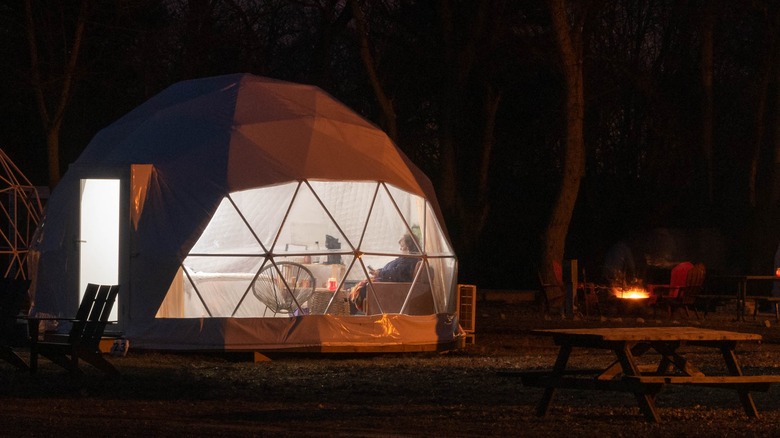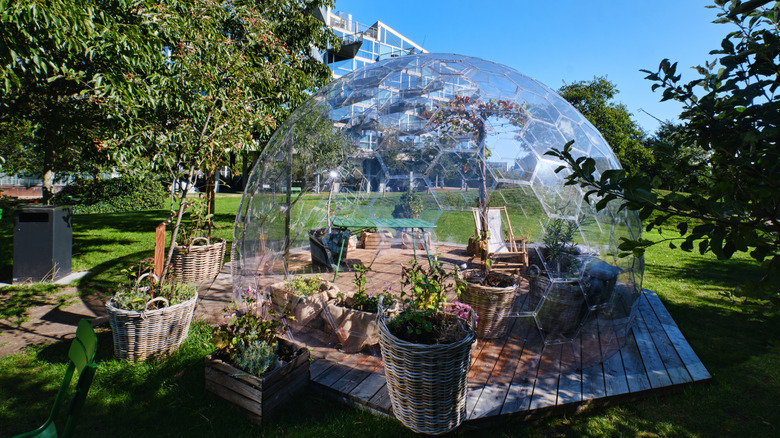Geodomes Are A Garden Trend That Allows You To Sleep Under The Stars
Have you ever stayed up late to stargaze in your garden, only for the night's chilly air or the pesky mosquitos to force you home to bed? Alas, although our outdoor areas bring us closer to nature, exposure to the elements can prohibit their enjoyment from time to time. That is, unless you have a geodome (geodesic dome) in the yard. These lightweight spherical structures have energy efficient walls that keep rain and cold temperatures out while affording a full view of the outdoors.
Geodomes originated in Germany in the 1920s, when an engineer by the name of Walther Bauersfeld designed the world's first geodesic structure. The movement picked up steam in the 1950s, when architect Buckminster Fuller got the first American geodome patents and built several of the structures. The 1960s hippie movement embraced geodomes as an environmentally friendly means of communal living. Nowadays, geodomes come in a range of sizes suitable for commercial, industrial, and residential use. They can be as large as the Montreal Biosphere or as small as about 25 to 40 feet in diameter — the perfect size for a dome in the yard. Below, you'll find out the advantages and disadvantages of owning a geodome and tips for adding one on your property.
Pros and cons of having a geodome
One of the primary advantages of geodomes is that these structures are highly versatile. While you can use them to sleep under the stars while protected from the elements, they also have plenty of other uses. For example, a geodome in the backyard is a great venue to host a winter party, as you and your guests can stay warm but bask in the dim, intimate atmosphere created by your patio lighting. Alternatively, you can use the geodome as an accessory dwelling unit (if local bylaws allow it), a fully furnished workspace that's separate from the home, or as a solarium where you can grow tropical plants.
Since geodomes are portable, you can relocate it within your property or move it elsewhere if necessary. Despite the portability, they're exceptionally sturdy. Their design, which incorporates few flat surfaces, protects these homes from hurricanes and affords a great deal of seismic resistance. The same design encourages air circulation within the unit and makes it easier to cool or heat the indoor air, which helps reduce energy costs.
One disadvantage of a geodome as a living or recreational space is that its sloped walls and circular footprint make it difficult to furnish. You may struggle to arrange large pieces of furniture snugly against the walls. Another con is that constructing a geodome is hardly a DIY task, as the structure is quite complex. Luckily, there are kits you can purchase and set up in your yard.
How to get a geodome in your yard
To add a garden geodome, you should contact a company that specializes in these structures like GeoDomeX. These buildings have an incredibly sophisticated design that eclipses traditional homes in complexity. In essence, the design of a geodome is comprised of multiple flat-surface triangles or hexagons made out of polycarbonate or glass that are interconnected to make the dome's frame. The imaginary plane along the points of these shapes is what gives geodomes its spherical appearance. Given the complexity, it's no surprise that DIY-built geodomes are often leaky and not as energy efficient.
Another complication arising with geodome garden additions is the need for permitting. Building and planning requirements vary significantly between jurisdictions, and officials may or may not consider a geodome to be an occupied structure (the former is more likely if the geodome is built on a foundation). If this is the case, you'll need to meet the zoning and building requirements of your county or municipality before the dome can be built. Unlike general contractors who build traditional homes, many geodome suppliers cannot help you pull the necessary permits and approvals. This means that, before deciding to situate a geodome in your yard, you must speak with the local building and planning departments and find out what the approval process is like for this type of structure. Also, find out how much it costs to build a geodesic home kit to see if the project is feasible given your budget.

